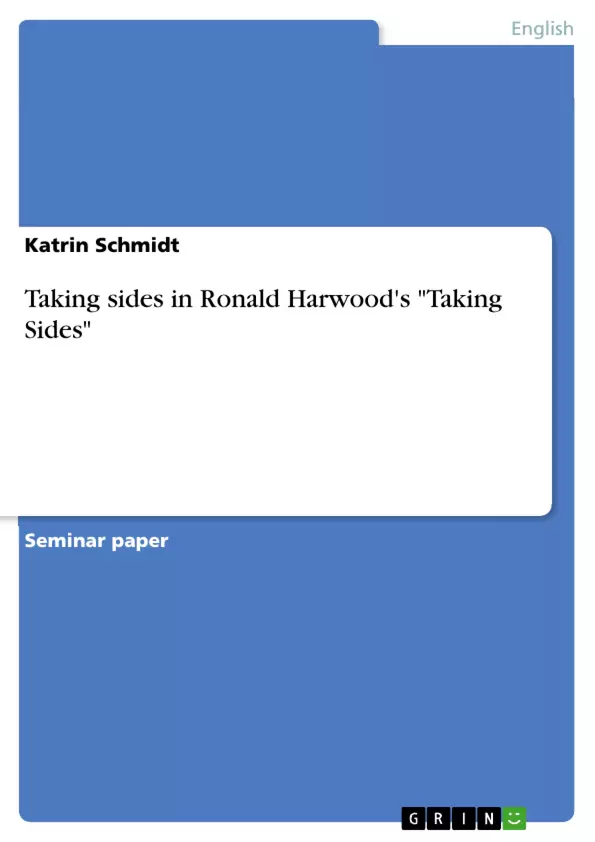Introduction
Wilhelm Furtwängler was a renowned German conductor before, during and after the Third Reich. He is still known today not least because of his ambiguous relationship with National Socialism. The playwright Ronald Harwood wrote a play named Taking Sides about Furtwängler’s denazification trial. The title appeals to the audience to take sides rather than summing up the plot of the play. Harwood makes his audience witness a dialogue of two contrasting perspectives: Furtwängler, on the one hand who is convinced of his innocence, and on the other, there is American investigator Major Arnold whose aim is to prove Furtwängler’s guilt. In the end it is up to the audience to take sides (cf. Glaap 2003, p. 13).
Questions the playwright poses at his audience are: “Why did Furtwängler stay in Germany whereas many other artists emigrated? (How) Did he manage to conduct the Berlin Philharmonic without making a deal with high-rank Nazis? Did he make up for his guilt by helping some Jews to escape? Can Arnold be interpreted as advocate of the Third Reich’s victims? (cf. ibid.).
This essay is not meant to finally expose the truth about Furtwängler’s guilt or innocence; other scholars have attempted to do that. Rather, my interest lies in revealing if Harwood succeeded in creating a neutral play that appeals to the audience to take sides without revealing his own personal opinion. With this working hypothesis I want to start by examining Harwood’s motivation to write the play. As a next step the importance of the setting will be examined. When analysing Harwood’s choice of characters and their function concerning their questioning or their support of Furtwängler, I will also examine Furtwängler’s role in the Third Reich as background information. By doing that, arguments taking sides for or against Furtwängler will also be taken into account. Furthermore, I will give an overview of the critic’s voice on Harwood’s play. In my conclusion I want to answer the question if Harwood succeeded in not taking sides.
Inhaltsverzeichnis (Table of Contents)
- Introduction
- The meaning of the setting – background information
- Harwood's choice of characters
- Taking sides for and against Furtwängler
- The function of the play
- Critics' reviews of Taking Sides
- Conclusion
Zielsetzung und Themenschwerpunkte (Objectives and Key Themes)
This essay examines the play "Taking Sides" by Ronald Harwood, focusing on its presentation of Wilhelm Furtwängler, a renowned German conductor during the Third Reich. The objective is to analyze if Harwood achieves neutrality in the play by prompting the audience to take sides without revealing his own personal opinion.
- Furtwängler's Ambiguous Relationship with the Nazi Regime
- The Role of Setting and Character Choices in Shaping Perspectives
- The Dilemma of the Artist Under Totalitarianism
- The Importance of Cultural Differences and Post-War Re-education
- The Ambiguity of Historical Events and the Difficulty of Taking Sides
Zusammenfassung der Kapitel (Chapter Summaries)
- Introduction: This section introduces the play "Taking Sides" and its central figure, Wilhelm Furtwängler, a renowned German conductor whose relationship with the Nazi regime remains ambiguous. The essay's objective is to examine whether the play achieves neutrality by presenting contrasting perspectives without revealing the playwright's own views.
- The meaning of the setting – background information: This chapter explores the historical context of the play, focusing on the denazification trials held in Berlin in the American Zone in 1946. It examines the cultural differences between Americans and Europeans after World War II and their differing perspectives on the re-education process. The chapter also discusses Harwood's own motivations for writing the play, highlighting his personal detachment to Furtwängler's case and his fascination with the ambiguity surrounding it.
- Harwood's choice of characters: This chapter analyzes the key characters in the play, focusing on Major Steve Arnold, the American investigator pursuing Furtwängler's case. The chapter examines Arnold's role in shaping the audience's perception of Furtwängler and how his own personal biases influence his actions.
Schlüsselwörter (Keywords)
The key themes and concepts explored in this essay include: Wilhelm Furtwängler, "Taking Sides," denazification trials, post-war re-education, cultural differences, artist and totalitarian state, ambiguity, neutrality, historical context, character analysis, and the difficulty of taking sides in complex historical events.
- Quote paper
- Katrin Schmidt (Author), 2006, Taking sides in Ronald Harwood's "Taking Sides", Munich, GRIN Verlag, https://www.grin.com/document/93533



